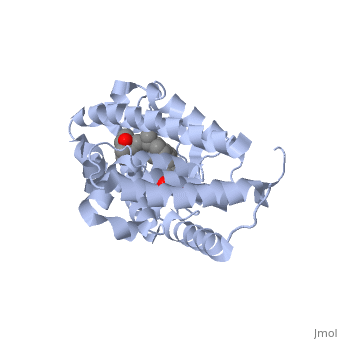1ie8
From Proteopedia
| Line 7: | Line 7: | ||
|ACTIVITY= | |ACTIVITY= | ||
|GENE= | |GENE= | ||
| + | |DOMAIN= | ||
| + | |RELATEDENTRY=[[1db1|1DB1]], [[1ie9|1IE9]] | ||
| + | |RESOURCES=<span class='plainlinks'>[http://oca.weizmann.ac.il/oca-docs/fgij/fg.htm?mol=1ie8 FirstGlance], [http://oca.weizmann.ac.il/oca-bin/ocaids?id=1ie8 OCA], [http://www.ebi.ac.uk/pdbsum/1ie8 PDBsum], [http://www.rcsb.org/pdb/explore.do?structureId=1ie8 RCSB]</span> | ||
}} | }} | ||
| Line 14: | Line 17: | ||
==Overview== | ==Overview== | ||
The crystal structures of the ligand-binding domain (LBD) of the vitamin D receptor complexed to 1alpha,25(OH)(2)D(3) and the 20-epi analogs, MC1288 and KH1060, show that the protein conformation is identical, conferring a general character to the observation first made for retinoic acid receptor (RAR) that, for a given LBD, the agonist conformation is unique, the ligands adapting to the binding pocket. In all complexes, the A- to D-ring moieties of the ligands adopt the same conformation and form identical contacts with the protein. Differences are observed only for the 17beta-aliphatic chains that adapt their conformation to anchor the 25-hydroxyl group to His-305 and His-397. The inverted geometry of the C20 methyl group induces different paths of the aliphatic chains. The ligands exhibit a low-energy conformation for MC1288 and a more strained conformation for the two others. KH1060 compensates this energy cost by additional contacts. Based on the present data, the explanation of the superagonist effect is to be found in higher stability and longer half-life of the active complex, thereby excluding different conformations of the ligand binding domain. | The crystal structures of the ligand-binding domain (LBD) of the vitamin D receptor complexed to 1alpha,25(OH)(2)D(3) and the 20-epi analogs, MC1288 and KH1060, show that the protein conformation is identical, conferring a general character to the observation first made for retinoic acid receptor (RAR) that, for a given LBD, the agonist conformation is unique, the ligands adapting to the binding pocket. In all complexes, the A- to D-ring moieties of the ligands adopt the same conformation and form identical contacts with the protein. Differences are observed only for the 17beta-aliphatic chains that adapt their conformation to anchor the 25-hydroxyl group to His-305 and His-397. The inverted geometry of the C20 methyl group induces different paths of the aliphatic chains. The ligands exhibit a low-energy conformation for MC1288 and a more strained conformation for the two others. KH1060 compensates this energy cost by additional contacts. Based on the present data, the explanation of the superagonist effect is to be found in higher stability and longer half-life of the active complex, thereby excluding different conformations of the ligand binding domain. | ||
| - | |||
| - | ==Disease== | ||
| - | Known diseases associated with this structure: Osteoporosis, involutional, 166710 (1) OMIM:[[http://www.ncbi.nlm.nih.gov/entrez/dispomim.cgi?id=601769 601769]], Rickets, vitamin D-resistant, type IIA OMIM:[[http://www.ncbi.nlm.nih.gov/entrez/dispomim.cgi?id=601769 601769]] | ||
==About this Structure== | ==About this Structure== | ||
| Line 30: | Line 30: | ||
[[Category: Tocchini-Valentini, G.]] | [[Category: Tocchini-Valentini, G.]] | ||
[[Category: Wurtz, J M.]] | [[Category: Wurtz, J M.]] | ||
| - | [[Category: KH1]] | ||
[[Category: kh1060]] | [[Category: kh1060]] | ||
[[Category: vdr]] | [[Category: vdr]] | ||
| - | ''Page seeded by [http://oca.weizmann.ac.il/oca OCA ] on | + | ''Page seeded by [http://oca.weizmann.ac.il/oca OCA ] on Sun Mar 30 21:18:34 2008'' |
Revision as of 18:18, 30 March 2008
| |||||||
| , resolution 1.52Å | |||||||
|---|---|---|---|---|---|---|---|
| Ligands: | |||||||
| Related: | 1DB1, 1IE9
| ||||||
| Resources: | FirstGlance, OCA, PDBsum, RCSB | ||||||
| Coordinates: | save as pdb, mmCIF, xml | ||||||
Crystal Structure Of The Nuclear Receptor For Vitamin D Ligand Binding Domain Bound to KH1060
Overview
The crystal structures of the ligand-binding domain (LBD) of the vitamin D receptor complexed to 1alpha,25(OH)(2)D(3) and the 20-epi analogs, MC1288 and KH1060, show that the protein conformation is identical, conferring a general character to the observation first made for retinoic acid receptor (RAR) that, for a given LBD, the agonist conformation is unique, the ligands adapting to the binding pocket. In all complexes, the A- to D-ring moieties of the ligands adopt the same conformation and form identical contacts with the protein. Differences are observed only for the 17beta-aliphatic chains that adapt their conformation to anchor the 25-hydroxyl group to His-305 and His-397. The inverted geometry of the C20 methyl group induces different paths of the aliphatic chains. The ligands exhibit a low-energy conformation for MC1288 and a more strained conformation for the two others. KH1060 compensates this energy cost by additional contacts. Based on the present data, the explanation of the superagonist effect is to be found in higher stability and longer half-life of the active complex, thereby excluding different conformations of the ligand binding domain.
About this Structure
1IE8 is a Single protein structure of sequence from Homo sapiens. Full crystallographic information is available from OCA.
Reference
Crystal structures of the vitamin D receptor complexed to superagonist 20-epi ligands., Tocchini-Valentini G, Rochel N, Wurtz JM, Mitschler A, Moras D, Proc Natl Acad Sci U S A. 2001 May 8;98(10):5491-6. PMID:11344298
Page seeded by OCA on Sun Mar 30 21:18:34 2008

